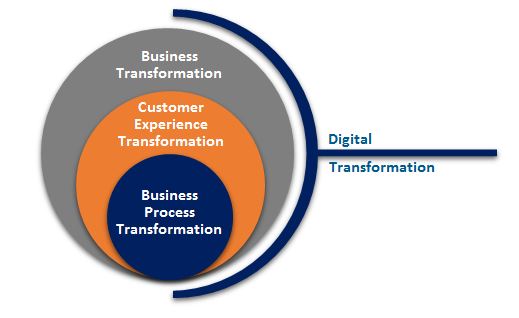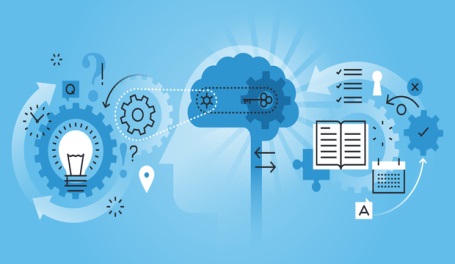
Would you like to start a conversation with other industry leaders to brainstorm a challenge or to just know more on a particular topic?
Engage in online discussions with your Peers
Start Now“When the digital transformation is done right, it’s like a caterpillar turning into a butterfly,but when done wrong, all you have is a really fast caterpillar.”
— George Westerman
The digital disruption currently taking place in the world is leading to the emergence of the Digital Economy. In many ways, the depth and extent of impact on companies due to the ever changing digital environment is so high that the digital transformation requires not just one, but ‘series of transformations’, and hence, is best termed as ‘Digital Metamorphosis’. The starting point is recognizing this as a digital revolution that comprehensively affects the market place, work place, and social networking space. It will restructure current jobs and roles, will rewrite competition, will change the way customers access and demand fulfilment of services, and will truly make the globe borderless to link suppliers and customers, and so on. As in any situation, strategy and execution need to work in tandem in order to stay relevant, sustain and create value in the present and for the future. This integrated approach applies to Digital Transformation as well. The Global India, being the global hub for Top Fortune 500 Companies, is clearly poised to convert this need into a huge opportunity and the Global In-house Centres (GICs) can then truly become the Global Innovation Centres for parent corporations as well as end clients!
Customers who are getting used to the efficacy of the ‘digital experience’ with Google, Amazon and Apple, are now pushing almost all established companies to rethink how they can leverage the digital world for their competitive advantage. Keeping it simple and clear is essential to demystify the understanding of the digital environment. There are three key terms that need clarity – what is digital, what is digital transformation and why digital execution, and then specifically elucidate ‘how’ organizations need to execute digital transformation to successfully create, innovate and sustain
‘a future ready and future relevant’ business.
A simple description of Digital is “applying the technologies, practices, processes and culture of the Internet era to respond to people’s/ customer’s raised expectations.”
What is Digital?
The term ‘Digital’ means different things to different people. A simple description of Digital is “applying the technologies, practices, processes and culture of the Internet era to respond to people’s/ customer’s raised expectations.”
The internet era does not refer merely to what started in the early 2000 as worldwide web, but needs to be seen as continuously changing as SMCAC becomes SMACIT (Social. Mobile, Analytics, Cloud and the Internet of Things)!
Digital has changed the way most of us shop, bank, travel, study, talk to friends and family, read books, listen to music, and watch films. It will increasingly change the way that people expect to work and live in the current environment.
Some people are 'digital natives' having grown up with the Internet. Others are 'digital immigrants' and are at different stages of adapting to or embracing of the digital world.
The above references of natives and immigrants apply not only to people but very much to organizations!

Several of the new age companies like ecommerce are, by design, digital companies. Most of the long tenured companies and some of the new businesses are the ones that need to ensure that they become part of the digital economy and undertake the Digital Transformation to become and stay ‘future relevant. Leaders at the top of the organisation must have a strong understanding of digital concepts and the benefits that digital brings to the organization.
Digital Transformation
As referred to earlier, Digital Transformation is not one kind of transformation but a ‘series of transformations’. Hence, by design it becomes complex and quite often ‘siloed’ in implementation, if only one of the transformation plan and execution is put in place. In order to demystify the Digital Execution, at most optimum, it is a combination of THREE different transformations that connect the entire business value chain from upstream to downstream – Business Process Transformation, Customer Experience Transformation and Business Transformation.
With a view to achieve the near term and long term strategic objectives of the corporation, Digital Transformation combines IT and Market focused revolution of a Company to become future relevant through three transformational series –
- technology enabled business models or considering new possibilities to compete, sustain and grow business (Business Transformation),
- new ways to interact with or deliver value to customers (Customer Experience Transformation), and
- redesigning or reimagining new ways of supporting business processes through digital technologies (Business Process Transformation).

Simply put, a digital transformation strategy aims to create the capabilities of fully leveraging the possibilities and opportunities of new technologies and to reap their impact faster, better and in more innovative way for the business in the future.
Transforming business processes is at the core of digital transformation with an ‘inside-out’ perspective, connecting the organization from one end of the spectrum i.e. upstream leading to downstream. The ‘outside-in’ perspective of Customer Experience links the downstream and springs into action by expanding ways of customer fulfilment, new customer segments, and enabling new customer expectations in the digital environment. Finally, the IT enabled business model or new possibilities builds a competitive advantage in the market place, directly benefiting the business sustenance and growth.
To reiterate, the advancements in IT and the business value chain connect is most essential to propel the Digital Transformation.
Digital Execution (Dx)
Given the ‘series of transformations’ as an integral part of Digital Transformation, the Digital Execution (Dx) i.e. Executing Digital Transformation, requires exploring and exploiting the power of IT with the entire business value chain and not in isolation or limited to one part of the value chain.
The ‘upstream-downstream’ connect makes the Dx as a unique capability in today’s digital world and there are four key factors that are driving this importance:
- Vast & Holistic: Digital Transformation in an organization is much more than IT Function or connecting IT with one or more functions. It is journey with multiple connected goals, cross functional across enterprise requiring bridges among functions and linking the business ecosystem as a whole.
- Digital Disruption: There is a dual impact. One, Digital Technology by itself is a source of disruption. Two, the Technology becomes part of a strategic solution that solves challenges, which can cause disruption in the market place. This needs to be kept in mind to sustain the execution momentum. Technology companies are becoming Financial Services Companies, and not just vice versa!
- Accelerating Pace: The pace of change in digital technologies is accelerating and getting faster than the pace of transformation in organizations. It is like ‘changing the stepney of the car while it is running’!
- Last Mile & Edge: The changes are happening at the last mile of the journey eventually affecting people and customers, causing a significant shift in customer behaviour and market context.
Hence, the Digital Execution framework is a critical requirement to successfully navigate effective implementation of Digital Transformation.
Global In-house Centres and Business Services organizations have a great opportunity to lead or partner or at least be part of each of the drivers of Dx, provide thought and execution leadership to the Digital Agenda of the parent organization.
Dx Quotient
Dx Quotient is the ‘ability of an organization to successfully achieve the outcomes of Digital Transformation’. The ability to implement depends on THREE key drivers (with 4 Elements each) for Digital Execution that cuts across the THREE transformational outcomes of Digital Transformation. They are:

The above three drivers with 12 key elements will enable to measure the extent of success of Digital Execution, and this is referred to as the Dx Quotient. The effectiveness of execution can be measured along these key elements for the key drivers, with As Is and To Be Assessment, to enhance the extent of impact.
The GICs and SSCs can apply the Dx Framework in three dimensions – Internal Processes of GIC i.e. all the Employee, Infra, and Support Functions related across GIC, Servicing Processes of GIC i.e. Transitioned processes for service delivery, and Domain Processes of the Parent Company, the Core Business of the Company. The key is to demonstrate their digital capabilities first on areas directly under their control or influence, so that they are called upon or a given a seat at the table for the Digital Transformation agenda of the organization. They can link each of the Dx drivers to each of the three types of processes – Internal, Servicing and Domain to showcase their Dx capabilities.
The role of the Top Management is to ensure that ‘the business and the organization remains future relevant and future ready’, in the fast paced digital world.
Management Drive
This calls for Top Management Drive to link the current IT systems, IT advancements and the rising Market Expectations to evolve the strategic execution plan of the Company. In fact, Digital acumen of Top Management is the foundation on which the Digital Execution is built to achieve a holistic success.
By the end of 2017, Two-Thirds of the CEOs and Top Management of the Global 2000 will have Digital Transformation at the centre of their corporate strategy. While CEOs and the Top Management Teams generally understand the strategic opportunities and threats of digital business, the success largely depends on ‘how well’ the Top Management has a clearly defined execution plan and drives the plans of the company.
The 4 Key elements of Management Drive are to focus on the following attributes for effective Dx:
- Top Management focus on ‘future relevant’ IT & Market driven strategic execution plan will essentially look at structures and processes to enable Innovation, taking stock of current IT systems while exploring the opportunities available from new advanced technology, comprehending Customer Journey for the top 5 business critical processes and an Agile Vision to keep the execution plan flexible without losing the momentum of execution.
- Focus on ‘rising expectations of Customer’ as the starting point from an outside in perspective and what kind of digital services are experienced by the Customers irrespective of the domain. This will provide a base for evolving the new ways possible to service the customers in the digital world.
- Ensuring Cross functional and Enterprise wide plan instead of ‘siloed’ single function plan. Silo Plan is by far the biggest challenge that the Top Management needs to avoid. By design the execution plan needs to be holistic, cross functional and enterprise wide, even if there is a phased implementation across functions. This will ensure that the cross functional linkages are considered while evolving the execution plan.
- Top Management needs to ensure Governance and Program Management support for systematic identification of challenges and possibilities for Dx. This will obviously include proactively considering organizational change process requirements. Digital Culture as a need, understanding digital natives and digital immigrants across the organization at all levels, Top Management knowledge integration to appreciate the new digital possibilities etc., Ideate, Innovate and Implement is a good mantra for effective governance and change enablement.
Organizational Alignment
One of the biggest requirements in Dx is to close the gap between the Top Management and Operational Management in terms of readiness and plan for implementation of Digital Transformation. A Capgemini Survey indicates that there is a gap of 40% between Senior Leadership and Employees on readiness to implement. The Organization alignment in a holistic way is about bringing together people, culture, technology and processes on a balance to ensure successful implementation.
Ideate, Innovate and Implement is a good mantra for effective governance and change enablement.
The 4 Key elements of Organization Alignment are to focus on the following attributes for effective Dx:
- Besides closing the gap and aligning Top Management and employees on readiness and execution momentum, there is a clear need for two key Functional Alignments viz., align HR & IT functions on Dx and align IT & Business areas. Cross Functional Teams & Knowledge Transfer with enabling structures, responsibilities and interfaces is another important requirement. Given the demands for new skills, there needs to be a balance between up skilling /reskilling & Recruiting, Hiring for Specific skills, building an ecosystem with Start Ups/ Incubators, and finally enabling the coexistence of Human & Bots as workforce. Up skilling and Reskilling are an integral part of the People dimension and detailed guidelines will enable employee engagement and achieving Dx effectiveness.
- Nurturing a Digital Culture is an integral part of the Organization alignment. Customer Centricity, Collaboration, Ecosystem interactions, Innovation, Data Driven, and supported by Risk Management Practices are few of the key requirements. Restructuring Performance Management to drive new digital agenda, support some level of failure rates as part of innovation and development is a critical aspect for driving Dx effectiveness.
- Processes End to End and Enterprise wide or at least Cross Functional is the sine qua non for avoiding silo execution. Investing in linking Front Office and Back Office (FOBO) is a big mind-set shift, since organizations tend to invest more in Front Office, not fully realizing that the back office operations need to be aligned to give the best customer experience during the customer journey at least on the business critical processes.
- Technology, by design is the heart of Dx, since this is one of the TWO most critical triggers for Dx. Having said, it is important to focus on use of Information beyond Technology and Outcomes not just Outputs to provide the best platform to enable organization alignment. New possibilities emerge from Information as an Asset of the organization to connect with customers or ecosystem to drive the business agenda through digital. Building Knowledge Management leveraging digital analytics as well as leveraging Automation for making processes more controlled and effective, is an important aspect of Technology alignment. Last but not the least, the ability to focus on enhancing efficiency of traditional systems with advanced technologies, while leveraging advanced technologies for Dx is a critical ingredient for Organization alignment.
Skill Development
The role of Skill development has gained utmost focus in the recent times as this too cuts across all elements and the outcomes for Dx. Even the Top Management needs to be up skilling themselves in terms of Digital Transformation Blueprint, Digital Execution, Governance etc.

This is one area where the ‘As Is and To Be assessment’ is most essential since significant effectiveness and value is derived by organizations while executing Digital Transformation.
The 4 Key elements of Skill Development are to focus on the following attributes for effective Dx:
Reverse Mentoring is a new learning skill/ technique that is being used specifically for Dx, where young digital natives mentor Senior Leaders to enable their knowledge spread and support them to take leveraging decisions as appropriate.
- First and foremost is to focus on Digital Culture Skills. This needs to be enterprise-wide and needs to be customized for various levels across the organization, and providing a modular focus for digital natives and digital immigrants, irrespective of levels. This could include Workshops on DX Outcomes & Drivers across levels, End to End Process, Customer Experience, FOBO, MDM etc. that will make a significant impact for Dx. Reverse Mentoring is a new learning skill/technique that is being used specifically for Dx, where young digital natives mentor Senior Leaders to enable their knowledge spread and support them to take leveraging decisions as appropriate. Also, since ecosystem assumes greater importance in the digital world, digital skills needs to include Ecosystem & Partnership Excellence skills to shift the mind-set towards enabling ‘outside in’ knowledge flowing to the internal teams. The digital focus on Internal processes are a good starting point to develop and nurture the culture in GICs/ SSCs and then propel the Dx for other Servicing & Domain Processes
- Digital Skills are fundamental to Digital Transformation so that one can explore, exploit these skills for creating competitive advantage and growth. Simply put, these will include Digital Security, Mobile Technologies, Big Data Analytics, Cloud Computing, IoT, Business Networks, Product/ Service Integration, InMemory Databases, Social Media, AI, Novel Interfaces, Block Chain etc. The Top Management specifically needs to appreciate the power of these technologies even if they are not technically savvy on these areas.
- Leadership Skills will have to be specific to Dx. These will include Cross Functional Project Management, Business Change Management, Entrepreneurship, etc., Given the disruptive nature of digital transformation, innovation and design thinking skills will need to become the DNA of the organisation. One new skill that makes Dx comparable to a chess game is Pattern Recognition. This combines intuition, holistic view of the digital board and lateral thinking to be continuously agile and make the next move towards the win.
- Learning Architecture has assumed new dimensions in the digital world and has become equally important as Learning Skills for successful Dx. This will focus on Portfolio of Skills to drive flexible roles instead of Fixed Roles.

Reskilling as a critical driver for employee engagement and promote the trend towards elearning, self-Learning and informal learning, as the digital natives are quite used to learning on their own or from computers. Supplementary mentoring can always be supported for such learning. Knowledge sharing, management and integration are being seen as a specific capability for Dx to provide sustaining capacity building within the organization.
Innovative Employee Exchange Programs with hi-tech companies are being pursued in a structured manner to aid in accelerating digital training. For instance, to step up its internet/ digital marketing initiatives, P&G has entered into an employee exchange program with Google to step up its internet marketing initiatives and scale-up digital skills. The learning measurement and analytics is becoming more and more tangible to enable the learners to monitor their development on their own.
Global In-house Centres and Business Services organizations have a great opportunity to lead or partner or at least be part of each of the drivers of Dx, provide thought and execution leadership to the Digital Agenda of the parent organization.
Way Forward
Digital Transformation is no longer a buzz word, it is real. The most optimum combination of the THREE transformations for Dx as well as the THREE Key drivers with 12 elements give a clear direction to the GICs and Business Services Organizations to expand their role – becoming proactive in demonstrating their capabilities to gain sponsorship from the parent company leadership. Many of the elements are more mind shifts than demanding investments, and hence the GIC leaders need to steer away from seeking investments before they even start their journey to support the digital agenda. Also, the leadership need to move away from the premise that the processes in GICs/ SSCs are only ‘back office’ and go beyond to focus larger transformational outcomes like enabling Customer Experience Transformation. When they gain the momentum, show case their proactive engagement, and can provide a business case for the Dx, then the investments will surely flow in.
This is a huge opportunity in the waiting for GICs/ SSCs to not only drive digital agenda of GIC/SSC Operations but also become an integral part of the Global/ Country teams to drive the digital agenda for the Corporation as a whole.
ABOUT THE AUTHOR

Ravi S Ramakrishnan is a seasoned business and people leader with invaluable experience of 35 years in finance, business and business process areas. He was instrumental in setting up the pioneering global offshoring operations at American Express. Having held leadership positions earlier in Hindustan Unilever, Murugappa Group and Eicher with CXO level responsibilities,Ravi is recognized as a thought leader in off shoring and business process domains. He uniquely combines exposure to multiple sectors of Indian and global corporations, and drives the vision and strategies for growth of RvaluE in the niche area of business process services through a team of professionals. Ravi is a Chartered & Cost Accountant and a Company Secretary.




